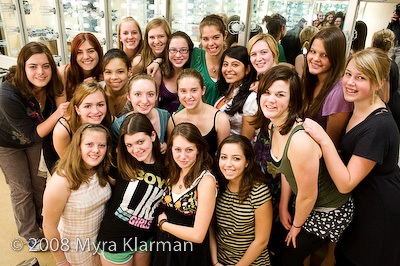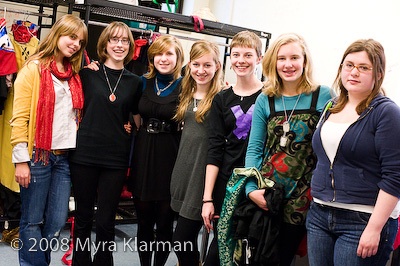Behind the Scenes at Pioneer’s ‘Miss Saigon’

Cast members of "Miss Saigon" in the makeup room before Friday night's dress rehearsal. The show opens tonight at 7:30 p.m., with performances Sunday and Nov. 14-16.
A cast member dressed in Army fatigues is doing a mic check. Above him, a cloud of theatrical smoke wafts from the stage into the auditorium. He sings a few lines then says, “Am I good?”
“You’re the best!” someone calls out from the group of students clustered around the orchestra pit, as they laugh and hoot and applaud.
It’s Friday night, the final dress rehearsal for Ann Arbor Pioneer Theatre Guild’s “Miss Saigon,” the world premiere of the popular play’s new school edition. On stage and off, it’s organized chaos – something anyone in theater would recognize as that nerve-flaying period when you can’t imagine how everything will come together, though it always does.
Susan Hurwitz, the show’s producer who works full-time for the guild, takes a break from resolving myriad minor crises to give The Chronicle a backstage tour, and to talk about the complexities of pulling off this kind of production.
“We’re always pushing the envelope,” she says, as a young girl in neon pink fishnet hose skitters by. She describes the show as a traditional love story under very tragic circumstances, but even as adapted for high school, it deals with adult issues: war, prostitution, children born out of wedlock, the impact of an occupying force on a country’s people. So as part of preparing for this performance, there’s been a strong educational component as well. Robin Wax, a retired Pioneer history teacher, created a curriculum for the production, including talks from a Vietnam veteran and a native Vietnamese citizen, a viewing of the documentary “Hearts & Minds,” and more.
Even students in the props crew looked at their work through the lens of learning about another culture. Paula Doering, a consultant hired to supervise the seven students on that crew, says that one of their tasks was to create bundles for fleeing Vietnamese characters. “They learned the sadness of having all your possessions wrapped up in one little bundle,” she said.
But clearly, these kids are also having a lot of fun, even as they take their tasks seriously. About 50 students are in the cast, and another 75 or so are involved in behind-the-scenes work – on props, scenery, costumes, makeup, lights, sound or other jobs.
In the costume shop, a student is mending on one of the four sewing machines in the crowded room, as cast members in various stages of dress wait for attention. In the paint shop, last-minute touch-ups are being made to scenery. Though the power tools stand silent in the scene shop, that’s where the nearly full-sized helicopter was built from wood, foam and plexiglass. It was a technical challenge to design, says Ciara Stella, the show’s scene shop supervisor, but not that difficult to actually build. It even flies – “in the theatrical sense,” she says, laughing.
In a hallway outside the theater, long folding tables are loaded with food: bowls of chips and veggies, boxes of pizza, soda, water, jars of peanut butter and jelly, and a large foil tin of franks and beans. This is the work of parent volunteers with the Pioneer Theatre Guild Booster Club, who provide dinner each night during technical week, the days leading up to the show’s opening.
The club’s main role is fundraising – it costs about $45,000 to put on a show like this. Revenue for the guild’s productions throughout the year comes in large part through fundraising, with a lesser amount from the school district. There’s an annual membership fee of $65 for each student involved, though the guild subsidizes families that can’t pay. Students are also expected to sell at least $100 in ads per year to bring in more revenue – those ads are published in the play’s program.

Pioneer students Tim VanRiper and Ashley Park play the title roles of Chris and Kim in "Miss Saigon."
Lesa Huget is president of the booster club – her daughter Hannah is on the sound crew for “Miss Saigon.” “This is really an extraordinary flagship program that the district should be very proud of,” she says. The fact that the guild has been chosen for the world premiere of two school adaptations – “Miss Saigon” and “Roald Dahl’s Willy Wonka,” performed last season – is a testament to the program’s caliber.
One thing that makes it unique is a robust partnership with the University of Michigan. The director of “Miss Saigon,” Etai BenShlomo, is a UM musical theater major, as is the assistant director and choreographer, as well as others who supervise the lighting and sound crews. The involvement of university students provides not only additional manpower but also an informal mentorship for the younger students.
In his director’s notes printed on the back of the play’s program, BenShlomo writes: “The social and political themes inherent in Miss Saigon are reflective of our own turbulent times. I firmly believe in theatre of social relevance and educational value. We are living in a significant time in history – the world is changing, anything is possible. It is important for all of us, but especially young people, to challenge ourselves – to tackle uncomfortable and relevant issues through any medium, be it literature, politics, or in our case, the arts. I hope that, through this challenging musical, our voices ring loud and true.”
It’s not that everything is perfect. Hurwitz bemoans the condition of the theatre’s facilities – there’s no sink in the main makeup room, the electrical system needs upgrading, the auditorium’s carpet is frayed and even in some places removed to expose concrete, and virtually everything could be updated. (Update: Hurwitz contacted The Chronicle today, reporting that later in the rehearsal a circuit overloaded, causing a small electrical fire in one of the backstage outlets. Though they were able to extinguish the fire quickly, it’s a concrete example of the need for upgraded facilities, she said.)
And though Pioneer has been lobbying for years to become a theater magnet school, the district hasn’t agreed to that. However, as Hurwitz pointedly notes, state-of-the-art theater facilities were built as part of the new Skyline High School. And Huget says that the booster club ends up paying for a lot of things that the district should be providing.
But on Friday, those concerns took a back seat to the more immediate challenge of smoothing over final kinks for this production – and there’s a bit of added excitement with news that Superintendent Todd Roberts is expected to attend tonight’s opening. The orchestra, directed by David Perample, has been working for over an hour on some particularly difficult spots in the score, places with tricky tempo changes or where cuing up with the singers has been a little rough. Finally, around 6:30 p.m., BenShlomo says, “OK, listen up, guys – take a break. When we come back in about 7 minutes, we’re gonna run.”
Editor’s note: Performances of Miss Saigon are on Nov. 8, 14 and 15 at 7:30 p.m. and Nov. 9 and 16 at 2 p.m. Tickets cost $12 for adults, $8 for students and seniors. More information is on the Ann Arbor Pioneer Theatre Guild’s website. More photos of “Miss Saigon” by photographer Myra Klarman are on her website.







It’s the morning after opening night of “Miss Saigon.” I woke up before 6 a.m. with the haunting music of multiple songs and the visions of one charged scene after another spinning through my mind. This show is yet another proud addition to the litany of Pioneer Theatre Guild (PTG) productions.
As my family’s out-of-town guest commented, “The depth of talent at this school is truly amazing.” There isn’t just one or two good performers, which would be the usual case for high school theatre, but there are twenty and counting outstanding performers!
All of us involved in this production, from the talented crew and cast to the hardworking production staff and parents are exhausted from all that leads up to opening night, yet energized for the remaining 4 performances. As I showed our guest the stage afterwards, one of the lead techies was jubilantly jumping up and down feeling the success of opening night, then she froze and said, “We have to reset the stage – we have a show to do tomorrow!”
I strongly encourage the Ann Arbor and neighboring communities to experience “Miss Saigon,” PTG-style!
Congratulations to all involved!